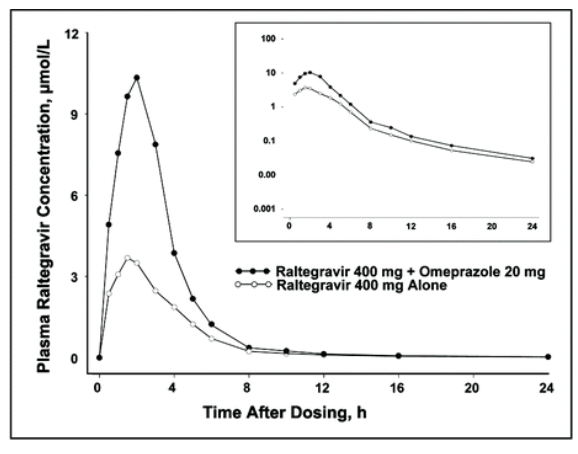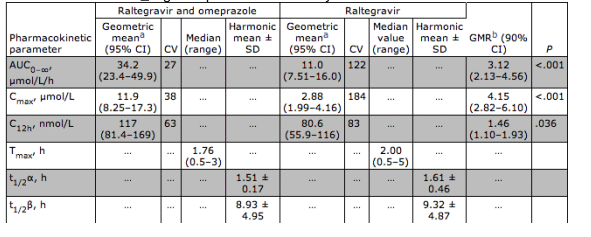| |
Effects of Omeprazole on Plasma Levels of Raltegravir
|
| |
| |
BRIEF REPORT
Clinical Infectious Diseases Feb 15 2009;48:489-492
Marian Iwamoto,1 Larissa A. Wenning,1 Bach_Yen Nguyen,1 Hedy Teppler,1 Allison R. Moreau,1 Rand R. Rhodes,1 William D. Hanley,1 Bo Jin,1 Charlotte M. Harvey,1 Sheila A. Breidinger,1 Neal Azrolan,1 H. Frank Farmer Jr.,2 Robin D. Isaacs,1 Jeffery A. Chodakewitz,1 Julie A. Stone,1 John A. Wagner1
1Merck & Co., Whitehouse Station, New Jersey; and 2Covance Clinical Research Unit, Daytona Beach, Florida
ABSTRACT: Raltegravir, a human immunodeficiency virus type 1 (HIV-1) integrase inhibitor, has pH_dependent solubility. Raltegravir plasma concentration increases with omeprazole coadministration in healthy subjects; this is likely secondary to an increase in bioavailability attributable to increased gastric pH. Increased gastric pH has been reported in HIV-1-infected individuals, and the effects of omeprazole in this intended population may be diminished. Further investigation is necessary.
"Overall, the data support the use of raltegravir in patients receiving gastric pH-altering agents with no dosage adjustment. Further investigation is necessary to more fully characterize the pharmacokinetics of raltegravir given in combination with gastric pH-altering agents in HIV-1-infected patients."
HIV-1 infection continues to be major worldwide health problem. A number of effective antiretroviral agents are available to patients, and new agents with new mechanistic targets continue to be developed [1]. Individuals infected with HIV-1 are treated with a cocktail of antiretroviral medications, often with supportive medications; as such, drug_drug interactions are particularly important considerations [1]. Depending on the degree of the effect, drug_drug interactions can be problematic and may lead to decreased efficacy or increased toxicity. Thus, the investigation of potential drug_drug interactions is important.
Raltegravir (ISENTRESS or MK_0518; Merck & Co.) is a member of a promising new class of drug for the treatment of HIV-1. Raltegravir is an HIV-1 integrase strand transfer inhibitor with potent in vitro and clinical activity [2]. The drug interaction profile of raltegravir is overall favorable with little indication of clinically meaningful interactions to date [2]. Investigations have focused primarily on interactions caused by effects on drug metabolizing enzymes; however, other effects, such as gastric pH modification, may also lead to clinically meaningful pharmacokinetic changes.
The intended population for raltegravir includes a proportion of patients receiving treatment with gastric pH-altering agents, such as omeprazole for gastric acid-related conditions. Based on the in vitro and in vivo properties of omeprazole and raltegravir, there is low probability that omeprazole would affect the metabolism of raltegravir and vice versa [3, 4]. Raltegravir is cleared primarily via metabolism with use of uridine diphosphate glucuronosyltransferase 1A1 [2]. Raltegravir has not been shown to be either an inducer or inhibitor of drug metabolizing enzymes [2, 3]. Omeprazole is also cleared primarily by metabolism but with use of the cytochrome P450 isozymes 2C19 and 3A. Omeprazole is a known inhibitor of cytochrome P450 2C19, 2C9, 3A, and 2D6 [4], but there are no reports implicating omeprazole as an inhibitor of glucuronidation. The increase in gastric pH that is secondary to omeprazole, however, may have an effect on the absorption and bioavailability of raltegravir, because raltegravir is sparingly soluble in media with low pH, but solubility increases at higher pH. Therefore, a Phase I study involving healthy subjects was performed to assess the safety, tolerability, and pharmacokinetics of single doses of raltegravir alone and coadministered with omeprazole.
Materials and methods. A randomized, 2-period, single_blind, crossover study involving healthy men and women was performed. Subjects received 1 of 2 treatments in a randomized fashion. Treatment A consisted of 4 days of placebo doses (the appearance matched that of 400-mg doses of raltegravir) followed by a single oral 400 mg dose of raltegravir administered in the fasted state on day 5. Treatment B consisted of 4 days of placebo doses (the appearance matched that of 400-mg doses of raltegravir) and 20 mg of omeprazole administered once daily for 4 days, followed by 400 mg of raltegravir administered 2 h after a 20_mg dose of omeprazole in the fasted state on day 5.
Healthy men and women, aged 18-55 years with a body mass index <32 kg/m2, were eligible for inclusion. Subjects were excluded from the study if they were smokers, were infected with HIV-1, had a significant past medical history of clinical concern, had donated or experienced recent significant blood loss, or anticipated receiving any prescription or nonprescription drugs during the study. All subjects provided written informed consent to participate in the study. The protocol was approved by the institutional review board of the study center and was conducted in accordance with the guidelines on good clinical practice and with ethical standards for human experimentation established by the Declaration of Helsinki.
Plasma samples were collected to determine raltegravir concentrations before treatment and up to 72 h after the receipt of the raltegravir dose. Plasma samples were analyzed using a validated reverse-phase high pressure liquid chromatography tandem mass spectrometry method, as described elsewhere [5]. Additional details regarding pharmacokinetic assessment can be found in the Appendix. Concentration at 12 h (C12h), maximum concentration (Cmax), and area under the concentration-time curve (AUC0-∞) were natural-log transformed before analysis. Ninety percent CIs were calculated for the mean differences between treatment groups (raltegravir with omeprazole vs. raltegravir alone) in C12h, Cmax, and AUC0-∞ and were based on an analysis of variance model with treatment as a fixed effect and subject as a random effect.
Results._A total of 14 subjects, 7 men and 7 women, were enrolled. All subjects met inclusion criteria and were in good general health. Subjects had mean body weights of 87.0 kg (range, 81.9-100.5 kg) and 67.8 kg (range, 62.0-76.1 kg) for men and women, respectively, and a mean age of 41 years (range, 22-51 years). Of the 14 subjects enrolled, 9 were white, 2 were African_American, 2 were Hispanic_American, and 1 was Native-American.
Raltegravir plasma concentration-time profiles, with and without coadministration of omeprazole, are shown in figure 1. Pharmacokinetic parameter values are presented in table 1.
Figure1. Arithmetic mean raltegravir plasma concentration-time profiles in healthy men and women after the single-dose administration of 400-mg raltegravir with or without the administration of 20_mg omeprazole once-daily (Inset: semilog scale).

Table1.Comparison of raltegravir plasma pharmacokinetics among healthy men and women who received single oral doses of 400-mg raltegravir with or without administration of 20_mg omeprazole once-daily.

NOTE.AUC0-∞, Area under the concentration-time curve from 0 h to infinity; C12h, concentration at 12 h; Cmax, maximum plasma concentration; CV, coefficient of variation; GMR, geometric mean ratio; t1/2a, initial-phase half-life; t1/2a, terminal-phase half-life; Tmax, time at maximum plasma concentration. Data regarding AUC0-∞ t1/2a were available for 10 subjects, and data regarding Cmax, C12h, Tmax, and t1/2a were available for 14 subjects.
Geometric means are computed from least squares estimate from an analysis of variance performed on the ln_transformed values.
GMR represents the ratio of the geometric mean value for patients receiving a raltegravir plus omeprazole versus those only receiving raltegravir.
The administration of single-dose 400-mg raltegravir was generally well tolerated when administered with 20_mg omeprazole in healthy subjects. There were no serious adverse experiences or discontinuations attributable to an adverse effect. Six subjects reported a total of 9 adverse experiences. All adverse effects were transient and rated mild in intensity. Only 1 of the adverse experiences was judged to be possibly drug related; this involved a decreased platelet count that increased to within normal range 3 days after the decrease.
Discussion._The aim of the study was to investigate the effect of a gastric pH-altering agent on the pharmacokinetics of raltegravir. Raltegravir is sparingly soluble in low pH media, with increasing solubility at more a basic pH. Because patients who might use raltegravir therapy might also take gastric pH-altering agents, an evaluation of the potential interaction of such agents on raltegravir pharmacokinetics was warranted. This study demonstrates that the coadministration of omeprazole and raltegravir in healthy subjects results in increased plasma concentrations of raltegravir, with a 3-4-fold increase in AUC and Cmax. The C12h for raltegravir was also increased but to a lesser extent. The potential mechanism for the increase likely involves an increase in gastric pH that results in increased solubility of raltegravir and increased absorption and bioavailability. Preclinical and clinical data for both omeprazole and raltegravir suggest that there is low probability of an interaction that involves metabolic clearance [3, 4]. The effect of omeprazole is more prominent during the initial phase of the pharmacokinetic profile, with a substantial effect on Cmax and a resulting impact on AUC. Omeprazole had a relatively minor effect on C12h, and similar half-life (t1/2) values were observed in both treatment groups, suggesting that omeprazole has no meaningful effect on the metabolism or clearance of raltegravir.
Drug disposition is also affected by membrane_bound transporters. Omeprazole has been shown to be an inhibitor of the efflux transporter P-glycoprotein [4]. Raltegravir is a P-glycoprotein substrate; therefore, P-glycoprotein inhibition might have potentially contributed to increased bioavailability of raltegravir. However, omeprazole's effect on the P-glycoprotein substrate digoxin is relatively modest; therefore, the several_fold effect observed on raltegravir by omeprazole is secondary to a more major influence on absorption, such as the likely gastric pH effect.
The effect of gastric pH alteration on raltegravir bioavailability needs to be placed in the context of the intended patient population. Some HIV-1-infected patients, particularly those with AIDS, are known to have increased baseline gastric pH and achlorhydria [6, 7]. An exploratory subgroup analysis of the sparse pharmacokinetic data available involving patients receiving concurrent gastric pH-altering agents, compared with patients not receiving these agents, suggests a smaller effect relative to that seen in this study of healthy subjects. The geometric mean ratio for the geometric mean observed C12h (with vs. without a gastric pH-altering agent) was 1.21 (90% CI, 0.83-1.76) and for the geometric mean of all observed concentration (Call) was 1.11 (0.85-1.45) (Appendix). One explanation of the dichotomous finding, comparing HIV-1-uninfected volunteers with HIV-1-infected patients, could be a difference in baseline gastric pH. Further investigation is necessary to more fully characterize the pharmacokinetics of raltegravir administered in combination with gastric pH-altering agents in HIV-1-infected patients.
Safety analysis of the Phase II and III studies have revealed raltegravir to be generally well tolerated [8, 9]. An exploratory subgroup analysis was performed to assess the safety profile of raltegravir in patients receiving any proton pump inhibitor and/or H2 blocker. Raltegravir was generally well tolerated with an overall safety profile similar to that observed in those patients who were not receiving gastric pH-altering agents. In the cohort of patients receiving a proton pump inhibitor and/or H2 blocker, serious clinical adverse effects, including those that were considered drug_related, were more common in the group that was receiving raltegravir. Review of the serious adverse effects did not identify a specific pattern to suggest a specific association with raltegravir. These data suggest that the modest pH_dependent effects on raltegravir levels are not a likely explanation for the difference in serious adverse effect frequency in the subgroup of patients receiving a proton pump inhibitor or H2 blocker. Additional details regarding the safety analysis can be found in the Appendix.
In summary, omeprazole increases the plasma concentration of raltegravir in healthy subjects; however, exploratory pharmacokinetic data in HIV-1-infected individuals demonstrate a reduced effect. Evaluation of the safety profile in healthy subjects and HIV-1-infected patients receiving gastric pH-altering treatments has not identified any areas of concern. Overall, the data support the use of raltegravir in patients receiving gastric pH-altering agents with no dosage adjustment. Further investigation is necessary to more fully characterize the pharmacokinetics of raltegravir given in combination with gastric pH-altering agents in HIV-1-infected patients.
|
|
| |
| |
|
|
|